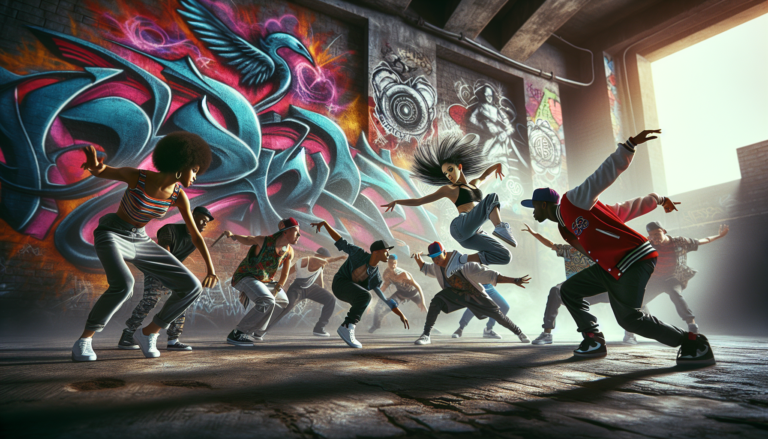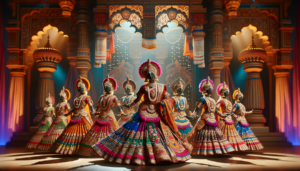Street dance is a vibrant and diverse art form that has captured the hearts of people around the world. Originating from urban environments, street dance encompasses a wide range of styles, each with its own unique history, techniques, and cultural significance. From the energetic moves of hip-hop to the intricate footwork of house dance, street dance has become a global phenomenon that continues to evolve and inspire.
In this article, we will delve into the world of street dance, exploring its origins, popular styles, and the impact it has had on dance culture worldwide.
Introduction to Street Dance
What is Street Dance?
At its core, street dance refers to dance styles that emerged from urban settings, often characterized by their improvisational nature and strong connection to music. These styles were developed by young people in cities across the United States, particularly in African American and Latino communities, as a means of self-expression and social interaction.
Street dance is known for its raw energy, individuality, and the ability to adapt to various musical genres. Dancers often engage in friendly battles or competitions, showcasing their skills and creativity in a supportive environment.
The Cultural Significance of Street Dance
Beyond its artistic merits, street dance holds immense cultural significance. It has served as a powerful tool for marginalized communities to express themselves, share their stories, and challenge societal norms. Through dance, individuals have found a way to cope with challenges, build a sense of belonging, and celebrate their identities.
Street dance has also played a crucial role in shaping popular culture. It has influenced music, fashion, and media, with many street dance styles crossing over into mainstream consciousness. Today, street dance is recognized as a legitimate art form, with dancers and choreographers pushing the boundaries of creativity and innovation.
History of Street Dance
Origins of Street Dance
The roots of street dance can be traced back to the 1970s in the United States. In the Bronx, New York, hip-hop culture emerged as a response to the socio-economic challenges faced by African American and Latino communities. Breaking, also known as b-boying or breakdancing, became one of the four core elements of hip-hop, alongside DJing, MCing, and graffiti.
Meanwhile, on the West Coast, funk styles like popping and locking were developed. These styles emphasized precise movements, isolation, and musicality, drawing inspiration from funk music and popular culture.
Evolution of Street Dance Styles
As street dance gained popularity, new styles began to emerge, each with its own distinct flavor and techniques. House dance, for example, originated in Chicago and New York in the 1980s, influenced by the house music scene. It incorporated elements of African dance, salsa, and tap, creating a fast-paced and energetic style.
Other styles, such as krump, waacking, and voguing, also gained prominence. Krump, which stands for Kingdom Radically Uplifted Mighty Praise, developed in Los Angeles as a means of expressing raw emotions and spiritual devotion. Waacking and voguing, on the other hand, have roots in the LGBTQ+ community, serving as forms of self-expression and empowerment.
| Style | Origin | Key Characteristics |
|---|---|---|
| Breaking | Bronx, New York | Acrobatic moves, footwork, freezes |
| Popping | Fresno, California | Muscle contractions, isolation, robotics |
| Locking | Los Angeles, California | Precise arm and hand movements, freezes |
| House Dance | Chicago and New York | Fast footwork, jacking, shuffles |
| Krump | Los Angeles, California | Aggressive, emotional, storytelling |
As street dance continued to evolve, it began to incorporate influences from around the world, including Latin American, African, and Asian dance styles. This fusion of cultures has enriched the street dance scene, creating a diverse and ever-changing landscape.
Popular Street Dance Styles
Hip-Hop Dance
Hip-hop dance is perhaps the most well-known street dance style, closely associated with hip-hop music and culture. It encompasses a wide range of techniques, including breaking, popping, locking, and freestyle.
Hip-hop dance is characterized by its improvisational nature and the dancer’s ability to interpret the music in their own unique way. Dancers often engage in battles, where they showcase their skills and creativity in a friendly competition.
Popping Dance
Popping is a street dance style that originated in Fresno, California, in the 1970s. It is characterized by sudden muscle contractions, or “pops,” which create a jerky, robotic effect. Poppers often incorporate isolation techniques, where they move specific parts of their body while keeping the rest still.
Popping has evolved to include various sub-styles, such as strutting, tutting, and animation, each with its own unique flair.
Locking Dance
Locking, another funk style, was created by Don Campbell in Los Angeles during the late 1960s. It is known for its precise and exaggerated arm and hand movements, combined with relaxed, flowing steps. Lockers often incorporate pointing, waving, and freezes into their routines.
Locking is performed to funk music and is often associated with a playful, comedic vibe. Dancers may draw inspiration from popular culture, mimicking characters or incorporating humor into their performances.
House Dance
House dance emerged from the house music scene in Chicago and New York in the 1980s. It is a fast-paced, improvisational style that emphasizes intricate footwork, quick turns, and a strong connection to the music.
House dancers often incorporate elements from other dance styles, such as African dance, salsa, and tap. The style is known for its “jacking” movement, where dancers pulse their torso to the beat of the music.
Breaking Dance
Breaking, also known as b-boying or breakdancing, is one of the original elements of hip-hop culture. It is characterized by acrobatic floor movements, power moves, and freezes.
Breakers, or b-boys and b-girls, often engage in battles, where they take turns showcasing their skills and trying to outdo their opponents. Breaking requires a combination of strength, flexibility, and musicality, with dancers adapting their moves to the rhythm and flow of the music.
Krump Dance
Krump is an energetic and expressive street dance style that originated in South Central Los Angeles in the early 2000s. It is characterized by exaggerated, aggressive movements that convey raw emotions and spiritual devotion.
Krump dancers, or krumpers, often incorporate stomps, chest pops, and arm swings into their performances. The style is known for its intense energy and the way dancers “battle” through movement, expressing their struggles and triumphs.
Waacking Dance
Waacking is a dance style that emerged from the disco era in Los Angeles during the 1970s. It is characterized by dramatic arm movements, pose strikes, and fast, rhythmic footwork.
Waackers often tell stories through their movements, expressing emotions and creating characters. The style is closely associated with the LGBTQ+ community and has roots in drag ball culture.
Voguing Dance
Voguing is a highly stylized dance form that originated in the Harlem ballroom scene of the 1960s. It is inspired by the poses struck by models in fashion magazines and is characterized by exaggerated, angular movements and a strong emphasis on attitude and self-expression.
Voguing is often performed in categories, such as “Runway” or “Hands Performance,” where dancers showcase their skills and creativity. The style has gained mainstream recognition through pop culture references and has become a symbol of empowerment for the LGBTQ+ community.
Techniques in Street Dance
Basic Techniques
While each street dance style has its own unique techniques, there are some fundamental elements that are common across many styles:
- Toprock: Upright dance moves performed while standing
- Downrock: Floor-based moves, often involving footwork and transitions
- Freezes: Poses or positions held for a moment, showcasing balance and control
- Isolations: Moving specific body parts while keeping the rest still
- Musicality: Dancing in sync with the rhythm, melody, and mood of the music
Mastering these basic techniques is essential for any street dancer, as they form the foundation for more advanced moves and styles.
Advanced Techniques
As dancers progress in their skills, they may incorporate more complex and challenging techniques into their performances:
- Power moves: Dynamic, acrobatic moves that require strength and momentum, such as windmills or flares
- Footwork: Intricate, fast-paced steps and patterns performed with the feet
- Threads: Smooth, continuous movements that link different dance elements together
- Waves: Fluid, rippling motions that travel through the body
- Tutting: Creating geometric shapes and patterns with the arms and hands, inspired by Egyptian hieroglyphs
Advanced techniques allow dancers to showcase their creativity, originality, and mastery of their chosen style. They often require a high level of physical conditioning, flexibility, and practice to execute effectively.
Street Dance Competitions and Events
Street dance competitions and events provide a platform for dancers to showcase their skills, connect with others in the community, and push the boundaries of their art form. These events range from local battles to international championships, attracting dancers from around the world.
Red Bull Dance Your Style
Red Bull Dance Your Style is a global street dance competition that challenges dancers to showcase their unique styles and creativity. The competition features a diverse range of street dance styles, including hip-hop, popping, locking, and house.
Dancers compete in one-on-one battles, with the audience determining the winner through a live voting system. The competition emphasizes individual expression and the ability to captivate the crowd. Red Bull Dance Your Style events take place in various cities around the world, culminating in a world final.
Juste Debout
Juste Debout is an international street dance competition that originated in France. It focuses on specific street dance styles, such as locking, popping, and house, with categories for solos, duos, and crews.
The competition attracts top dancers from around the globe, who compete in preliminary rounds before advancing to the finals. Juste Debout is known for its high level of skill and the opportunity for dancers to showcase their mastery of their chosen style.
The Notorious IBE
The Notorious IBE (International Breakdance Event) is a prestigious breakdance competition held annually in the Netherlands. It features b-boys and b-girls from around the world competing in various categories, including solo battles and crew showdowns.
The event also includes workshops, panel discussions, and live music performances, making it a celebration of hip-hop culture as a whole. The Notorious IBE is known for its high-energy atmosphere and the incredible skill level of its participants.
Summer Dance Forever
Summer Dance Forever is a multi-day street dance festival held in Amsterdam, Netherlands. It features competitions, workshops, and performances across a wide range of street dance styles, including breaking, popping, locking, house, krump, and more.
The festival attracts thousands of dancers and spectators from around the world, creating a vibrant and inclusive atmosphere. Summer Dance Forever is known for its high-quality programming, with renowned dancers and choreographers teaching workshops and judging competitions.
BBIC
BBIC (Battle of the Year International Championships) is one of the oldest and most prestigious breakdance competitions in the world. It features top b-boy crews from various countries competing for the title of world champion.
The competition includes regional qualifiers, with winning crews advancing to the world finals. BBIC is known for its intense battles, innovative routines, and the camaraderie among dancers from different parts of the globe.
Conclusion
Street dance is a dynamic and ever-evolving art form that has captured the hearts and minds of people around the world. From its humble beginnings in urban communities to its current status as a global phenomenon, street dance has proven its power to unite, inspire, and transform.
The Future of Street Dance
As street dance continues to grow and evolve, it is exciting to imagine what the future holds. With new styles and techniques emerging, and dancers pushing the boundaries of what is possible, the potential for innovation is limitless.
Technology is also playing an increasingly important role in the world of street dance. Social media platforms have made it easier than ever for dancers to connect, share their work, and learn from each other. Online tutorials and virtual classes have made street dance more accessible to people around the world, regardless of their location or background.
Street Dance as a Global Phenomenon
Street dance has truly become a global phenomenon, with dancers and enthusiasts from every corner of the world. It has the power to transcend language, culture, and social barriers, bringing people together through a shared love of movement and expression.
As street dance continues to gain recognition and respect as an art form, it is important to remember its roots and the communities that gave birth to it. By honoring its history and embracing its diversity, we can ensure that street dance remains a force for positive change and a source of inspiration for generations to come.






